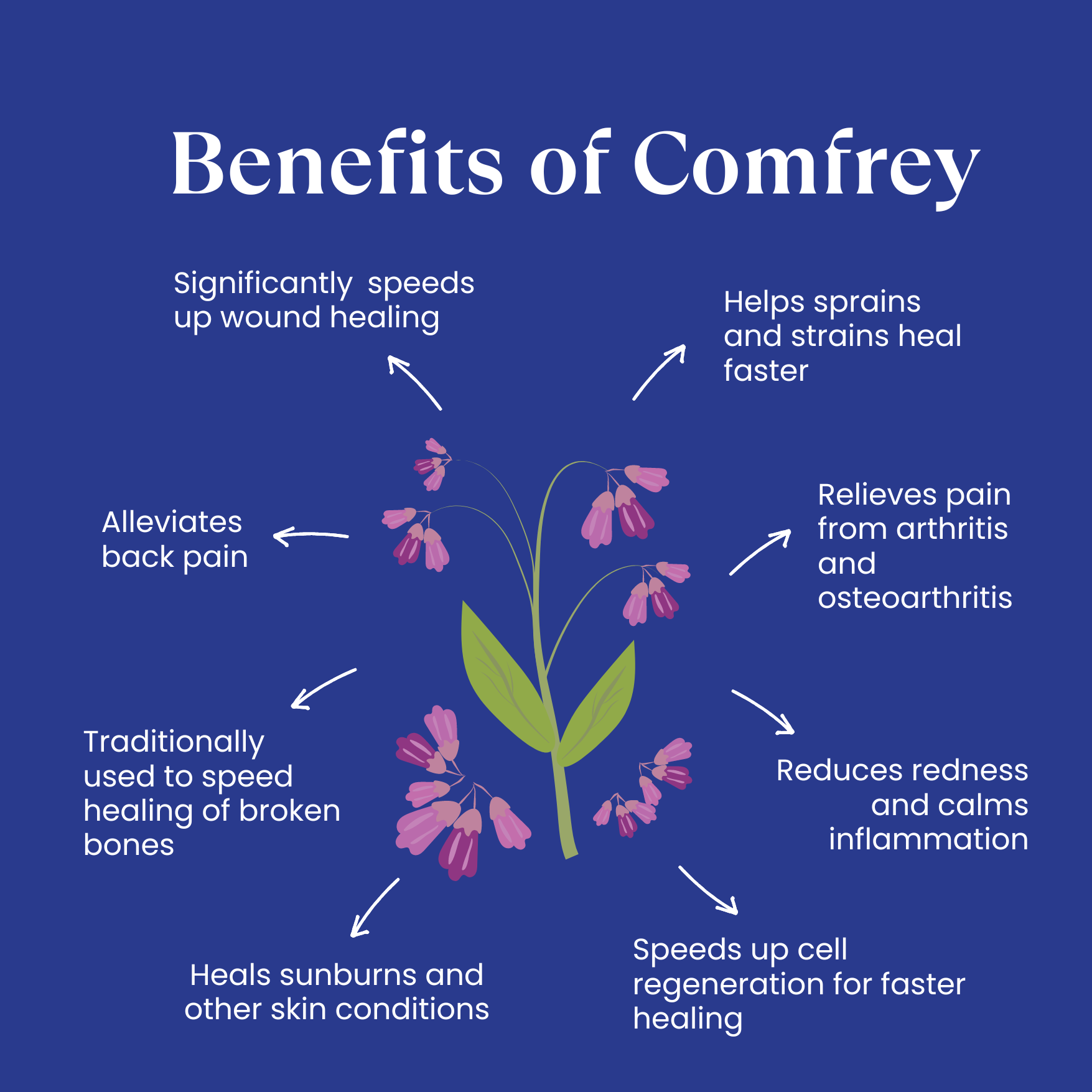For all the natural medicine mavens out there, you know the magic of comfrey plants. For those new to the natural healing world, allow us to introduce you to this incredibly healing super plant.
What is Comfrey?
Also known as Symphytum Officinale, the common comfrey plant stands out with its large, hairy leaves and purple or white flowers.
This botanical marvel increases cell regeneration for faster healing and has been used for thousand of years to heal injuries, reduce pain, and calm inflammation. And it's not just folklore—comfrey's benefits are backed by a wealth of clinical studies and scientific research. So, whether you're a plant aficionado or just curious, comfrey is a must-have in your natural remedy arsenal - keep reading for all its healing benefits (and the science to back it up).
Benefits of comfrey
Speeds up wound healing
Comfrey roots and leaves contain called allantoin, which helps new cells grow so wounds can heal faster. It's so powerful that it's not actually recommended for deep wounds as it may cause the outer skin to heal too fast before the deeper layers have totally healed.
In a study of 278 patients with fresh abrasions, an active-level comfrey root extract ointment shaved 3 days off the healing time compared to a low-dose comfrey extract ointment. Talk about fast-tracking your recovery!

Alleviates back pain & other aches and pains
Multiple studies have shown that comfrey speeds healing and decreases pain in people with muscle and joint pain, sprains, strains, and bruises.
In one double-blind, placebo-controlled, multicentre randomized controlled trial, 120 patients with acute upper or lower back pain were treated with either comfrey root fluid extract cream or a placebo. The results were incredible - pain levels decreased by 95.2% in the comfrey extract group vs only 37.8% in the placebo group.
Effective for arthritis and painful osteoarthritis
Studies have found that a topical comfrey ointment significantly eases arthritis and osteoarthritis pain, rivaling NSAIDs but without the nasty side effects.
Speeds recovery of sprains and strains
A study compared a symphytum herb extract cream (comfrey cream) against popular NSAID diclofenac and found comfrey to be more effective for use on acute unilateral ankle sprains - both to speed healing and reduce pain.
Helps with skin healing
Comfrey is nature's super effective skin healer. Packed with allantoin to boost new skin cell growth, rosmarinic acid to shield you from UV damage, and tannins to zap redness and inflammation, it's your skin's new best friend.
Multiple clinical studies show comfrey effectiveness on sunburns too, just as well as, if not better than, diclofenac gel, an over-the-counter medication used for topical pain relief.
Find comfrey in:
-
Our Wound Warrior Balm – formulated to significantly speed the healing of sprains, strains, burns, bruises, cuts and scrapes, and insect bites.
-
Our Lavender Lemon Balm Lip Balm: formulated to cure cold sores fast.
-
Our Tattoo Aftercare Balm: proven to heal new tattoos 3x faster and instantly brighten and intensify existing ink.

Your comfrey questions answered
Is comfrey really toxic?
In 2001, the FDA banned the use of oral comfrey products after studies found it could be toxic to the liver. When used externally, however, comfrey is a safe and highly effective anti-inflammatory and pain reliever with no known side effects.

Is comfrey legal?
Comfrey is banned from oral supplements and products, but allowed in topical comfrey preparations like creams and ointments.
What is the plant comfrey used for?
Comfrey is an incredibly healing medicinal plant that's been used for thousands of years to relieve pain, reduce inflammation, speed skin healing, heal sprains, strains, and minor cuts faster, and reduce discomfort related to conditions like arthritis and back pain.
How to use comfrey for bone healing
Also known as knit-bone, comfrey has been used across the world to heal bone fractures faster - usually applied externally in the form of ointments, extracts, or pastes to the injured area. In natural medicine, it is believed to calm the nervous system, increase circulation, and detoxify the body to increase cellular regeneration and speed healing.
Who should not use comfrey?
Mount Sinai advises pregnant and breastfeeding women to avoid taking comfrey internally, as well as anyone with liver disease, cancer, or alcoholism.
___________________________
Have more questions about comfrey or other healing botanicals? Send us a message anytime, we love chatting plants.
- Team Blue Heron xo





